Globalisation is a big part of our world today, bringing both good and bad changes. It has helped grow economies and share cultures, improving many lives. Yet, it has also caused job losses and harmed the environment, worrying many people.
It’s important to understand both sides of globalisation. This way, we can enjoy its benefits and reduce its negative effects.
Recent numbers show that over 1,200 new rules on trade have been added by G20 countries. These rules affect global trade and economic growth. While trade has grown, it has also led to job losses and environmental harm.
For example, giving China special trade status cost the U.S. 3.2 million jobs, including 2.4 million in manufacturing. The U.S. trade deficit with Japan in 2013 was $78.3 billion, causing 896,000 job losses.

The effect of globalisation on the economy is complex. It has brought growth and cultural exchange but also job losses and environmental damage. To make the most of globalisation, we need to understand its challenges and find ways to overcome them.
We must balance the benefits of trade and economic growth with protecting our communities and the environment.
Key Takeaways
- Globalisation has both positive and negative effects on economies and societies.
- The globalization benefits of increased trade and economic growth have improved the lives of many people around the world.
- The globalization drawbacks of job losses and environmental degradation have raised concerns about the impact of globalisation on local communities.
- Understanding the dual nature of globalisation is key to navigating its complexities and maximizing its benefits while minimizing its drawbacks.
- The key to maximizing the benefits of globalisation while minimizing its drawbacks is to balance the need for economic growth with the need to protect local communities and the environment.
- Globalisation has led to increased economic growth, but it has also resulted in significant trade imbalances and job losses.
Understanding Globalisation in the Modern World
Globalisation has been changing the world for centuries. It means more global integration of economies, societies, and cultures. This change comes from new technology, trade, and investment, making countries more connected.
The history of globalisation goes back to ancient times. The Silk Road was an early example of trade routes. But, the modern era of globalisation started in the 20th century. This was thanks to institutions like the International Monetary Fund (IMF) and the World Trade Organization (WTO). They helped make trade free and countries more connected.
Some key factors driving globalisation include:
- Technological advancements
- Trade agreements and international institutions
- Foreign investment and economic integration
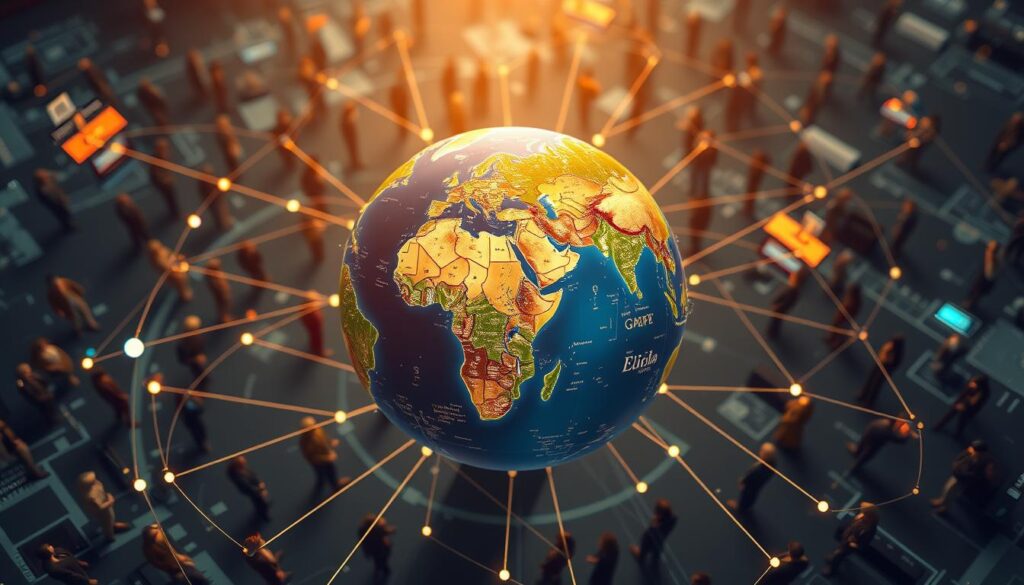
In conclusion, to understand globalisation today, we need to know its history and how it works. We must find ways to enjoy the benefits of global integration while avoiding its downsides. This is key for fair and lasting growth.
Economic Impact of Global Markets
Global trade has boosted economic growth by giving nations access to more labor and resources. This has led to economic growth and new chances for businesses and people. It also makes prices drop, helping both rich and poor countries.
Global trade helps move goods and services across borders, boosting global trade and cooperation. This can lead to more jobs, investments, and better living standards. But, it also brings challenges like job loss and income gaps.
Some key benefits of global trade are:
- More access to new markets and customers
- Improved efficiency and competitiveness
- Boosted economic growth and development
As the world gets more connected, global trade and market competition will grow more important. Understanding global markets’ economic impact helps us tackle economic growth challenges. This way, we can work towards a better future for everyone.

| Country | Economic Growth Rate | Global Trade Volume |
|---|---|---|
| United States | 2.5% | $1.5 trillion |
| China | 6.1% | $2.5 trillion |
| European Union | 1.8% | $3.5 trillion |
Cultural Exchange and Identity in a Connected World
Globalization has made it easier for people from all over to share their cultures. This has made our lives richer, letting us enjoy and learn from different traditions. Yet, it also makes it hard to keep our local ways alive in a world that’s getting smaller.
About 70% of city dwellers see themselves as part of a global culture. This change has both good and bad sides for local traditions and identities. It brings more diversity and understanding, but it can also make all cultures seem the same, losing the special things about each place.
The effects of globalization on culture and identity are clear in some numbers:
- 80% of global markets are dominated by Western cultural products, outpacing local cultural offerings.
- 90% of the world’s cultural consumption is expected to gravitate towards popular media produced in Western countries.
- Up to 70% of cultural expressions in non-Western countries are at risk of being marginalized due to globalization.

In short, cultural exchange and identity in today’s world are complex. While sharing cultures can be enriching, we must also protect our local traditions. This way, we can keep our cultures diverse and inclusive, making the world a better place for everyone.
| Category | Percentage |
|---|---|
| Cultural consumption | 90% |
| Cultural expressions at risk | 70% |
| Global markets dominated by Western cultural products | 80% |
Technology and Digital Transformation
The fast pace of technological advancements has driven digital globalization. It makes global connectivity faster and more efficient. This change has reshaped how businesses work, people talk, and information spreads worldwide.
The global digital economy was worth US $11.5 trillion by 2016, as the World Bank reported. This shows how big of an impact digital tech has on the world’s economy.
Some good things about digital globalization include:
- More access to info, education, and online services anytime
- It’s easier and faster for companies to enter new markets
- Data insights help improve productivity and open up new markets

Digital tech has also made e-commerce grow. It helps businesses reach more people, no matter where they are. But, there are also downsides like not everyone having access to digital tech. There are also worries about rules and keeping data safe.
As the world gets more connected, we need to tackle these problems. We must make sure everyone gets to enjoy the good things about digital globalization.
| Benefits of Digital Globalization | Challenges of Digital Globalization |
|---|---|
| Increased accessibility of information and services | Unequal access to digital technology |
| Lower barriers to market entry | Potential regulatory issues |
| Data insights leading to productivity improvements | Cybersecurity threats |
Environmental Implications of Globalisation
Globalisation affects the environment in many ways, causing pollution, climate change, and damage to ecosystems. The rise in transportation due to global trade has led to more greenhouse gas emissions. To lessen this, we need to focus on sustainable development, aiming to reduce our carbon footprint and adopt eco-friendly habits.
Some major environmental worries linked to globalisation are:
- Deforestation and habitat loss due to increased demand for resources
- Overfishing and marine pollution, threatening biodiversity
- Climate change, resulting from increased energy consumption and emissions
It’s vital for countries to work together to face these environmental challenges. Alone, no nation can handle the scale and complexity of these issues. Through international agreements and collaborations, we can share knowledge, technologies, and best practices. This helps in sustainable development and reduces environmental harm.
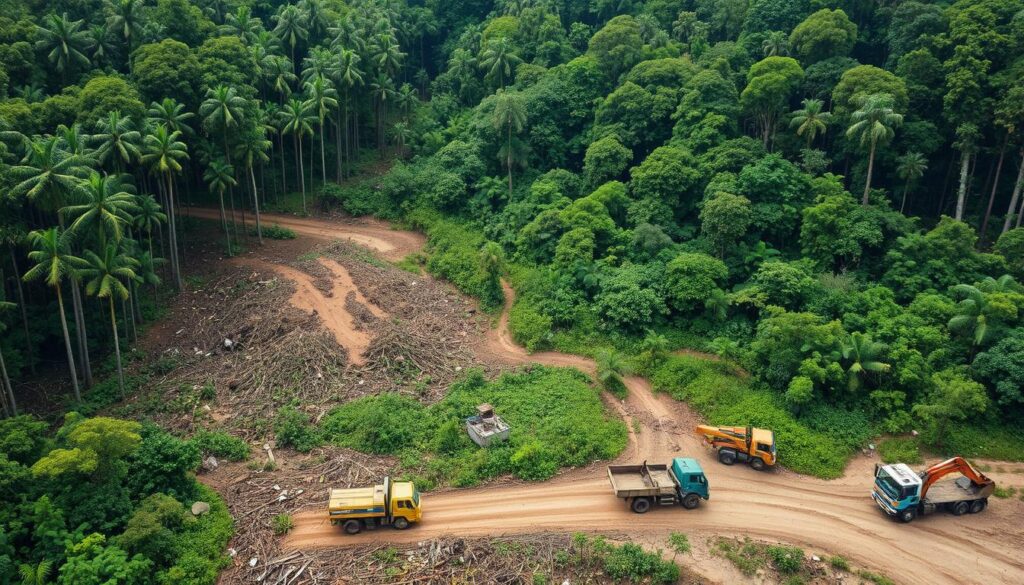
By focusing on protecting the environment and promoting sustainable development, we can strive for a fairer and greener global economy. This is achieved through global cooperation and collective action. Together, we can make positive changes and lessen the negative effects of globalisation on our planet.
| Environmental Issue | Causes | Effects |
|---|---|---|
| Climate Change | Greenhouse gas emissions, deforestation | Rising temperatures, sea-level rise, extreme weather events |
| Pollution | Industrial activities, transportation, agriculture | Air and water pollution, health problems, ecosystem damage |
| Deforestation | Agriculture, urbanisation, logging | Habitat loss, biodiversity decline, soil erosion |
The Complete Advantages and Disadvantages of Globalisation
Globalisation is a big part of our world today. It has both pros and cons of globalization that people talk about a lot. The good side includes more economic growth, cultural sharing, and working together globally. But, there are also downsides like harming the environment, unfair labor practices, and losing cultural diversity.
Some of the main benefits of globalisation are:
- More competition means lower prices for us
- Cultural exchange helps us understand each other better
- Working together globally can prevent wars
A table below shows the pros and cons of globalization in a clear way:
| Pros | Cons |
|---|---|
| More economic growth | Environmental harm |
| Cultural exchange and understanding | Exploiting workers |
| Global cooperation and less conflict | Loss of cultural diversity |
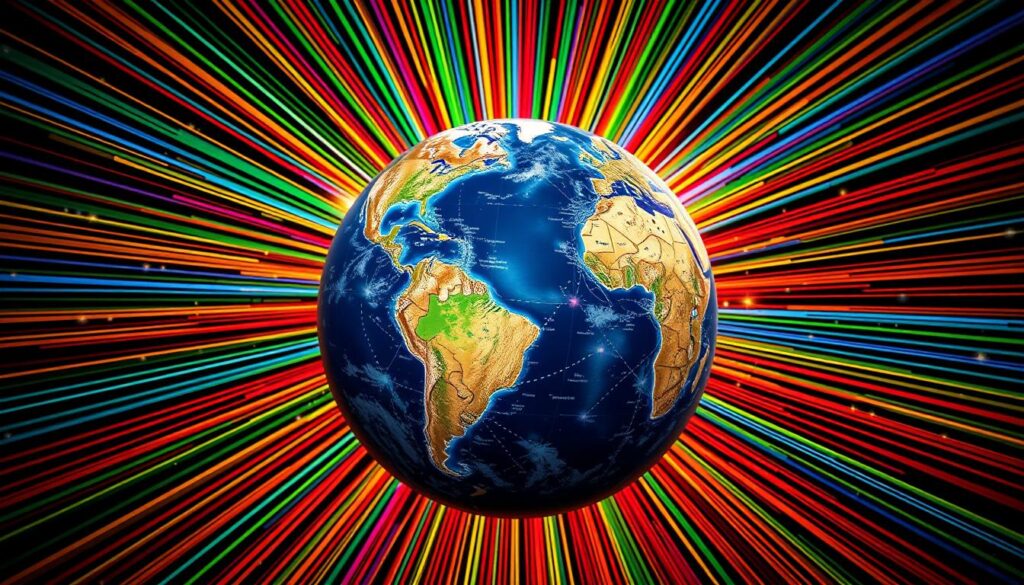
In summary, globalisation has both good and bad sides. It’s important to consider these points and aim for a fair and green global economy.
Impact on Employment and Labor Markets
Globalization has a big impact on jobs and labor markets. It brings both good and bad effects. It changes how jobs are created, how much people earn, and who earns more than others.
The link between globalization and jobs is complex. Some places see more jobs, while others lose them. In advanced countries, the average job pays 2.5 times more than similar jobs in developing countries. This shows the need for skills and training to keep up globally.
Some important stats on globalization’s effect on jobs are:
- Real wages in advanced countries went up by about 0.5% each year from 1999 to 2009. In Africa and Latin America, it was 1.5%, and in developing Asia, almost 8%.
- Immigrants make up 10-15% of the workforce in advanced countries. This has a small effect on wages over time.
- Manufacture exports from developing countries grew more than four times from 1985 to 2008. This helped wages get closer together.
As the global job market changes, we must tackle its challenges and chances. Investing in skills and training is key. It helps countries prepare their workers for the global economy and lessens the bad effects of globalization on jobs and labor markets.

Healthcare and Medical Innovation
The spread of diseases across borders is a big worry due to globalization. With three million people traveling internationally every day, the risk of diseases spreading is higher. But, thanks to medical innovation, we can now treat and prevent diseases better.
In many developing countries, getting healthcare is hard. Only 10% of internet users are from these countries. This shows we need to work harder to improve global health and healthcare access everywhere.
Some important facts about how globalization affects global health are:
- Approximately 4 million people die from smoking-related causes every year.
- The number of diabetes cases worldwide is projected to increase by 46% by 2010.
- Up to 70% of tobacco-related deaths will occur in developing countries.

To tackle these issues, we need to work together and come up with new medical innovation solutions. By improving healthcare access and focusing on global health, we can aim for a healthier and fairer world.
| Category | Statistic |
|---|---|
| International Travelers | 3 million per day |
| Internet Users in Developing Countries | 10% |
| Smoking-Related Deaths | 4 million per year |
Educational Opportunities in a Global World
Global education is now a key part of learning today. International study programs and digital learning platforms are changing education. They offer students a chance to study abroad and see the world.
Global education brings many benefits. Students learn from top educators and use the latest research tools. Digital learning lets students access education from anywhere, making it more open to everyone.
International Study Programs
International study programs are getting more popular. Many schools offer them, letting students study abroad. This lets students experience different cultures and learn new languages.
Some benefits of these programs include:
- Access to top education and research tools
- Learning from famous educators and experts
- Improving language and cultural skills
- Meeting students and professionals from all over
Knowledge Transfer Benefits
Global education offers many knowledge benefits. Students get to use a wide range of educational resources. Digital learning makes it easy to access these resources from anywhere.
Some key benefits include:
- Using the latest research tools and facilities
- Learning from top educators and experts
- Developing critical thinking and problem-solving skills
- Being ready for a global job market
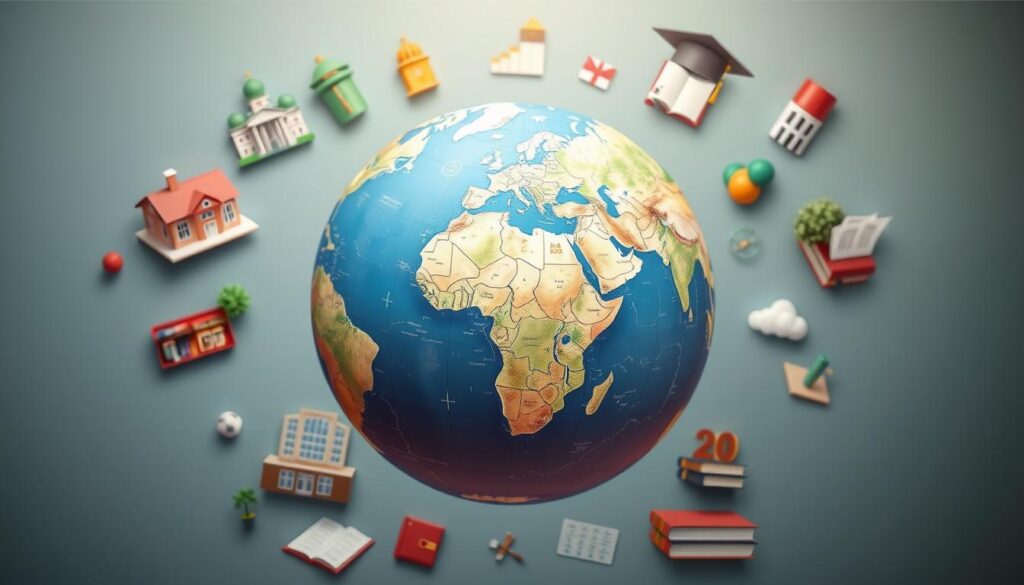
Digital Learning Platforms
Digital learning platforms have changed how we learn. Many schools now offer online courses and degrees. These platforms make learning flexible and accessible from anywhere.
Some benefits include:
- Learning online is flexible and convenient
- Access to many educational resources and courses
- Learning from famous educators and experts
- Improving critical thinking and problem-solving skills
Small Business in the Global Economy
Small business globalization is a big part of the global economy. It offers global market access and many chances for growth. The World Bank says about 30 million small businesses in the U.S. help create jobs and boost the economy. Also, global SMEs make up 60-70% of jobs and 50% of GDP in many countries.
The growth of entrepreneurial opportunities comes from easier access to global markets. This has helped develop manufacturing and improve economies in developing countries. The Peterson Institute for International Economics (PIIE) found that removing trade barriers has been key. Some benefits of small business globalization include:
- More access to global markets and customers
- Being more competitive with lower costs
- Getting new technologies and innovations
- Chances for partnerships and collaborations
But, small businesses face challenges too. They must deal with big corporations, follow rules, and adapt to different cultures. Yet, the good things about small business globalization are more than the bad. It opens doors for growth and expansion.
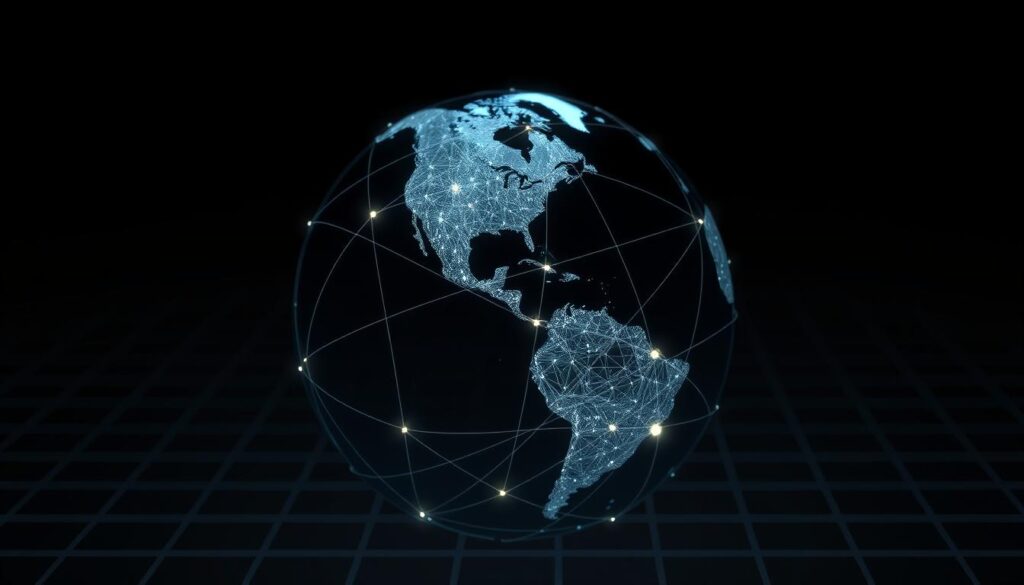
The global e-commerce market was worth $4.28 trillion in 2020. It’s expected to grow at 6.29% from 2021 to 2028. This growth comes from more global market access and new entrepreneurial chances. Here are some benefits of small business globalization:
| Benefits | Description |
|---|---|
| Increased access to global markets | Provides a platform for growth and expansion |
| Improved competitiveness | Reduced operating costs and access to new technologies |
| Access to new technologies and innovations | Enables businesses to stay competitive and adapt to changing market conditions |
Political and Governance Challenges
Globalization has brought many benefits, but it also brings big challenges to governance and international relations. As the world gets more connected, we need better policy coordination and cooperation. The third web source says international cooperation is key to solving global problems, showing the need for globalization governance that focuses on working together.
The international relations scene is very complex, with many players and interests. To deal with this, countries must use diplomacy and set up cooperation frameworks. This can mean joining international groups, making trade deals, and working on issues like climate change and economic growth.

Big challenges in globalization governance include finding a balance between national interests and global cooperation. We also need to tackle economic inequality and make sure everyone benefits from globalization. By focusing on policy coordination and cooperation, countries can tackle these issues and build a fairer, more prosperous world for everyone.
Future Trends in Globalisation
The future of globalization will be influenced by global trends and economic forecasting. Recent data shows global trade in merchandise is expected to grow only 0.8% in 2023. This is a drop from the forecasted 1.7% growth. This slowdown could greatly affect the future of globalization.
Important trends include the rise of digitally enabled trade in services and the growing influence of emerging markets. The share of global trade in goods has recovered but is trending down. On the other hand, digitally enabled trade in services has not slowed down and is expected to keep growing.
Here are some key statistics that highlight the trends shaping the future of globalization:
- Global trade volumes grew 2.1 times faster than real GDP from 1990 to 2007.
- Trade in services has grown more than 60 percent faster than goods trade over the past decade.
- Services create roughly one-third of the value that goes into traded manufactured goods.
Looking ahead, economic forecasting will be key in shaping the future of globalization. Understanding the trends and factors driving globalization helps us prepare for the challenges and opportunities ahead.
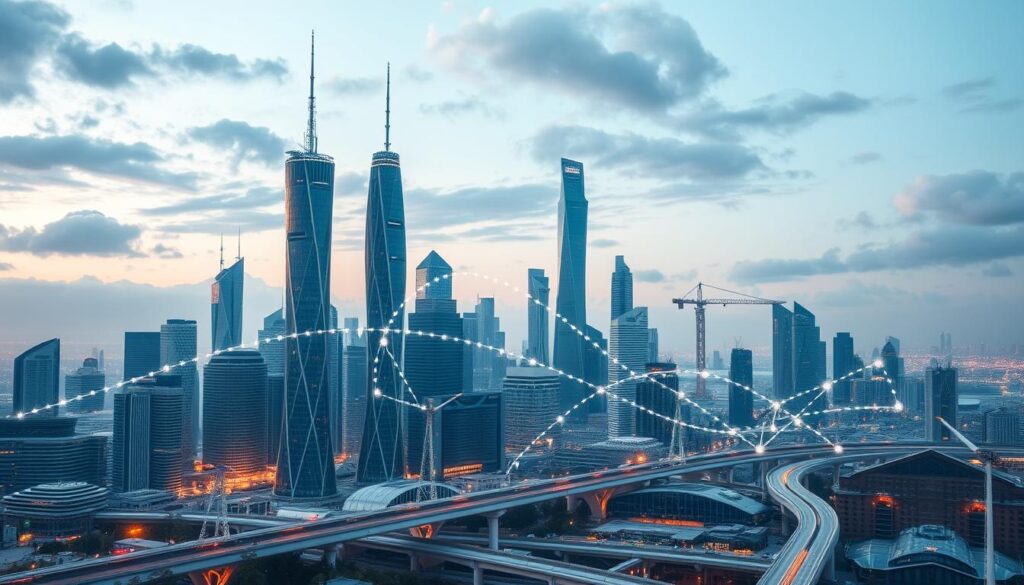
| Year | Global Trade Growth | Global GDP Growth |
|---|---|---|
| 2023 | 0.8% | 3.2% |
| 2022 | 1.7% | 3.5% |
Social Impact and Community Changes
Globalization has changed communities a lot in recent years. It’s important to see how it affects community changes and social cohesion. Cultural exchange and identity play big roles in globalization. They can have both good and bad effects on local communities.
Some key effects of globalization on communities include:
- Increased access to new cultural products and services
- Improved understanding of foreign values and attitudes
- Potential loss of cultural identity in smaller communities
Globalization has also led to community changes like more migration and urbanization. This has made communities more diverse. But, it also raises worries about social cohesion and the chance for social unrest.
A World Bank study found that globalization has made nations less likely to go to war. It also shows that more cross-border investment can help both the sending and receiving countries economically.

In conclusion, globalization’s impact on communities is complex. It has brought many benefits, like new cultural experiences. But, it also raises concerns about community changes and social cohesion. We need to understand these effects and strive for a more united and inclusive global community.
| Aspect of Globalization | Positive Impact | Negative Impact |
|---|---|---|
| Cultural Exchange | Increased access to new cultural products and services | Potential loss of cultural identity in smaller communities |
| Community Changes | Increased migration and urbanization | Potential for social unrest |
| Social Cohesion | Improved understanding of foreign values and attitudes | Concerns about social cohesion |
Conclusion
Globalization has changed the world in many ways. The global trade has grown from $8 trillion in 2000 to over $19 trillion in 2021. This shows the big economic chances that globalization offers.
Even though poverty has gone down, the wealth hasn’t been shared fairly. The top 1% has gotten most of the wealth. This has made inequality worse.
The cultural and tech advancements from globalization have both helped and hurt us. Big companies have grown, affecting local economies and traditions. But, they also harm the environment with bad practices.
We need to understand the good and bad sides of globalization. This will help us move forward.
Looking ahead, globalization will keep changing our world. We can make it better by using its chances and fixing its problems. We need to work together, be creative, and make sure everyone benefits from globalization.
FAQ
What is globalization?
Globalization means the world’s economies, cultures, and societies are more connected. This happens through fast exchanges of ideas, people, goods, services, and capital across borders.
What are the key drivers of globalization?
Key drivers include tech advances, like in communication and transport. Also, free trade and investment policies, big companies, and the movement of people and money.
What are the economic benefits of globalization?
It brings bigger markets, more competition, and lower prices. It also helps economies grow by sharing goods, services, and investments.
How does globalization impact cultural exchange and identity?
It boosts cultural exchange, enriching traditions and ideas. But, it also challenges local cultures and can lead to a loss of diversity.
What is the role of technology in facilitating globalization?
Tech, like the internet and mobile devices, has made global connections faster. It changes how businesses work, people talk, and information is shared.
What are the environmental implications of globalization?
It increases carbon footprint and environmental harm. This is due to more transport, production, and consumption. We need sustainable efforts and global cooperation to fix this.
How does globalization impact employment and labor markets?
It can create jobs and opportunities, but also risks job loss and income inequality. Skills training is key to managing these effects.
How does globalization affect healthcare and medical innovation?
It spreads medical knowledge and technologies, improving health care. But, it also highlights global health disparities.
What are the educational opportunities presented by globalization?
It opens up education through international programs and digital learning. This prepares students for a global job market.
How do small businesses navigate the global economy?
Small businesses face growth chances in global markets but also competition and cultural hurdles. They must adapt and comply with global rules.
What are the political and governance challenges associated with globalization?
It challenges national sovereignty, needing new international cooperation and governance. This is to handle policy coordination and global risks.
What are the future trends in globalization?
Trends may include shifts in economic power, tech impacts, and emerging markets’ roles. These will bring both chances and challenges.
How does globalization impact social structures and community cohesion?
It can have both good and bad effects on social structures and community ties. It depends on how communities interact with global forces.